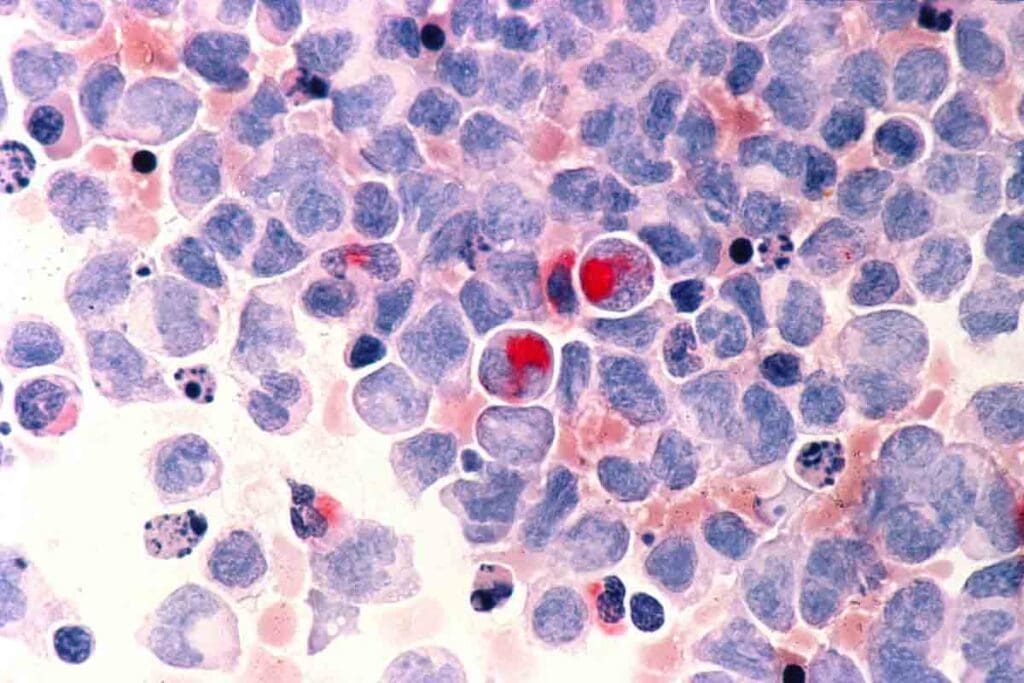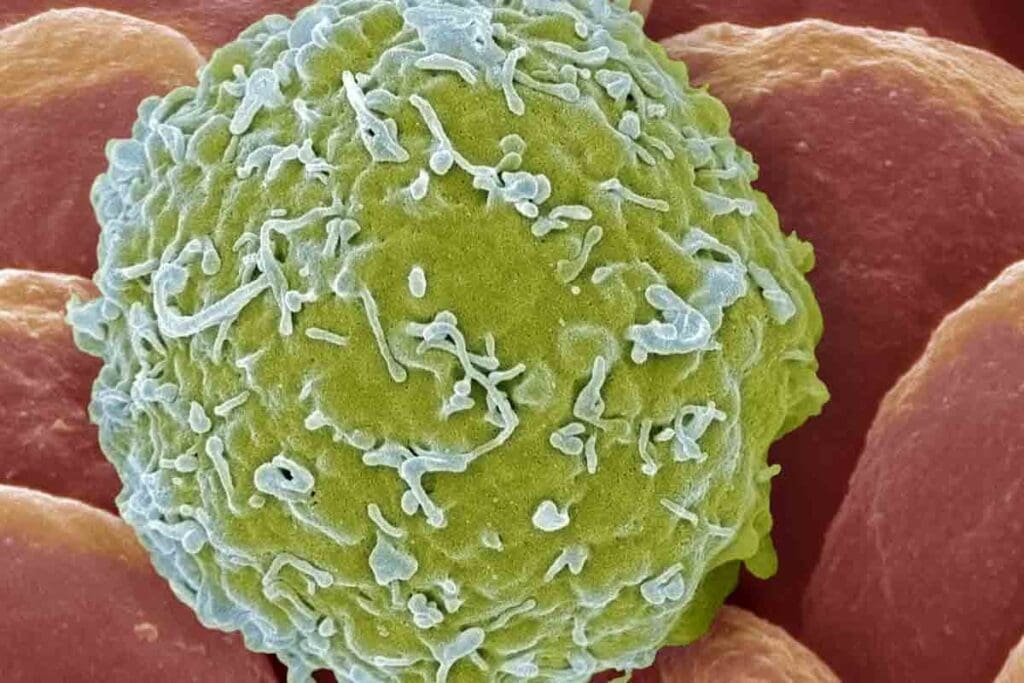Last Updated on November 20, 2025 by Ugurkan Demir

Leukemia is a cancer that affects the blood. It causes white blood cells to grow abnormally. Dark spots on the spine and unexplained skin symptoms can be scary. They might mean there’s a blood disorder.Learn leukemia dark spots on spine and related skin symptoms, causes, and early warning signs.
At Liv Hospital, our team uses the newest ways to check for these symptoms. We look at how leukemia affects the skin and the body.

Leukemia is a complex cancer that affects the body in many ways. It disrupts normal blood cell production. To understand the skin and spine symptoms, we need to know the basics of leukemia and its impact on health.
Leukemia starts in the blood-forming cells of the bone marrow. It’s a cancer where abnormal white blood cells grow too much. These cells are key for fighting off infections. But, when they grow out of control, they take over the bone marrow, affecting normal blood cells.
In a healthy body, the bone marrow makes blood cells in an orderly way. But, leukemia messes with this process. The abnormal white blood cells fill up the bone marrow, reducing normal blood cells. This can cause fatigue, infections, and bleeding problems.
There are several types of leukemia, each with its own traits. The main types are:
Each type of leukemia has its own symptoms and outlook. Knowing the specific traits of the disease is key.

It’s important to know why dark spots appear on the spine in leukemia patients. Leukemia is a blood cancer that can affect the spine in different ways.
Leukemia cells can invade the bone marrow and tissues around the spine. This invasion can cause bone damage and lead to dark spots seen on scans.
The process involves several key factors:
Leukemia cells can spread to other tissues, including the spine. This can cause tumors or chloromas, leading to spinal lesions.
The clinical implications of extramedullary involvement are significant:
Dark spots on the spine in leukemia patients often mean the disease is more advanced. This can suggest a worse prognosis.
| Clinical Feature | Prognostic Implication |
| Spinal Lesions | Advanced disease, potentially poorer outcome |
| Extramedullary Involvement | Increased risk of complications, need for aggressive treatment |
| Neurological Symptoms | Potential for long-term deficits if not promptly treated |
Leukemia patients often see different skin symptoms. These signs can show how the disease is affecting them. It’s key for both patients and doctors to know about these symptoms.
Petechiae are small spots on the skin from tiny blood vessel breaks. In leukemia, these spots can show up anywhere, like on the feet, legs, and stomach. They are usually red, brown, or purple and don’t disappear when pressed.
Petechiae are more common in some leukemia types, like those with low platelet counts. They show the body’s trouble making blood clots.
Bruising and ecchymosis are common in leukemia patients. They happen when blood leaks into the skin, causing discoloration. This is often because of low platelet levels.
Leukemia cutis is when leukemia cells get into the skin, causing lesions or nodules. It’s a clear sign of the disease. These can be nodules, papules, or plaques and can appear anywhere on the body. They might also cause itching or pain.
Leukemia cutis is more common in certain leukemia types, like acute myeloid leukemia (AML). Spotting it is important for diagnosis and treatment.
White blood cells play a key role in our immune system. They help fight infections and diseases. The connection between white blood cell count and cancer is complex, involving many factors.
A normal white blood cell count is between 4,500 and 11,000 cells per microliter of blood. Counts outside this range can signal health problems. An abnormal count doesn’t always mean cancer. It could be due to infections, inflammation, or other reasons.
To know if a white blood cell count is normal or not, let’s look at the ranges:
| White Blood Cell Count (cells/μL) | Status |
| Below 4,500 | Low (Leukopenia) |
| 4,500 – 11,000 | Normal |
| Above 11,000 | High (Leukocytosis) |
An elevated white blood cell count can be linked to cancer, like leukemia. But it’s not the only cause. Many conditions, including infections and inflammation, can also raise the count.
Important factors in interpreting a high white blood cell count include:
Many conditions can cause an elevated white blood cell count, including:
Understanding why a white blood cell count is high requires a detailed medical check-up.
It’s important to know where leukemia skin symptoms show up. This helps catch the disease early. Leukemia can cause different skin problems in various parts of the body.
Petechiae are small spots on the skin from tiny blood vessel bleeding. In people with leukemia, these spots often appear on the feet and legs. This is linked to leg leukemia, where cancer cells get into the skin.
Seeing these spots can worry patients. Leukemia petechiae on feet might mean the disease is getting worse. It could be a sign of leukemia cutis, where cancer cells attack the skin.
The trunk and back also see leukemia skin symptoms. These can be petechiae, bruising, and ecchymosis. Seeing these signs here means the disease is affecting the whole body.
The stomach area isn’t safe from leukemia skin symptoms either. Rash and bruising on legs can also show up in the stomach. This is because of low platelet counts or cancer cells in the skin.
Some body parts get leukemia skin symptoms more often. This is because of blood flow, pressure, and cancer cells in the skin. Knowing this helps doctors diagnose and treat leukemia better.
| Body Region | Common Symptoms | Possible Causes |
| Feet and Legs | Petechiae, bruising | Low platelet count, leukemia cutis |
| Trunk and Back | Petechiae, ecchymosis | Systemic involvement, leukemia cell infiltration |
| Stomach Region | Rash, bruising | Low platelet count, leukemia cell infiltration |
Knowing where leukemia skin symptoms appear helps doctors diagnose and treat better. This improves how well patients do.
Leukemia symptoms can change a lot, and how they change varies from person to person. It’s important for both patients and doctors to understand these patterns to manage the disease well.
Yes, leukemia symptoms can change over time. This is because the disease affects blood cells differently in each person. Some people might see their symptoms get better or worse, then better again. This can happen for many reasons, like the type of leukemia, how well treatment is working, and the person’s overall health.
Factors influencing the variability of leukemia symptoms include:
A rash from leukemia, like petechiae, can also change. Sometimes, it might seem to go away, only to come back. This could be because the leukemia is acting up again or because of treatment effects.
It’s essential to note that any changes in skin manifestations should be reported to a healthcare provider, as they can provide valuable insights into the disease’s progression and the effectiveness of the treatment plan.
How skin symptoms from leukemia change can vary a lot. Some people might see their symptoms get worse or more frequent, while others might have more stable or changing symptoms.
Monitoring skin manifestations is key because they can show how the disease is doing and how well treatment is working. Doctors can check these symptoms regularly to adjust treatment and help symptoms improve.
Understanding leukemia pain is key to managing it well. Leukemia is a blood and bone marrow cancer. It can cause different kinds of pain and discomfort.
Leukemia patients often wonder if the disease is painful. The answer is not simple. Pain can differ a lot from one person to another.
Is Leukemia Painful? Yes, leukemia can be painful. Pain can come from bone marrow expansion, organ enlargement, or leukemia cells in tissues and organs.
Does leukemia pain come and go? Pain can change over time. Some feel constant pain, while others have pain that comes and goes.
“Pain is a highly subjective experience and can be influenced by multiple factors, including the stage of leukemia, the effectiveness of treatment, and individual pain tolerance.”
Expert Opinion
Different leukemias can cause different pains. For example:
| Type of Leukemia | Common Pain Locations | Causes of Pain |
| Acute Leukemia | Bones, joints | Bone marrow expansion, leukemia cell infiltration |
| Chronic Leukemia | Abdomen (due to splenomegaly or hepatomegaly) | Organ enlargement |
Managing pain well is important for leukemia patients’ quality of life. Pain management can include:
We know managing leukemia pain needs a full approach. It must cover physical, emotional, and psychological aspects. By working with healthcare providers, patients can find good pain management strategies.
It’s important to know how fatigue and low blood counts are linked in leukemia. Fatigue is a big problem for leukemia patients, affecting their life quality a lot.
Fatigue in leukemia patients comes from many sources, but low white blood cell counts play a big role. When white blood cells are low, fighting infections is harder, making patients feel very tired. “Fatigue is one of the most debilitating symptoms for our patients,” a leading hematologist. “It’s not just about feeling tired; it’s a profound lack of energy that can be debilitating.”
Low white blood cell counts, or leukopenia, can happen because of leukemia or treatments like chemotherapy. This makes infections more likely and adds to the feeling of tiredness.
It’s hard to tell if someone has iron deficiency or leukemia because both can cause fatigue and low blood counts. Iron deficiency anemia, for example, can make people tired because of fewer red blood cells or hemoglobin.
But leukemia-related fatigue often comes with other symptoms like weight loss, night sweats, and bone pain. Distinguishing between iron deficiency anemia and leukemia requires a thorough diagnostic process.
Leukemia patients often have systemic symptoms along with skin issues. These can include fever, night sweats, and feeling generally unwell. These signs can show how advanced the disease is or what type of leukemia it is.
For example, those with acute leukemia might have more severe symptoms than those with chronic leukemia. Knowing these symptoms is key to giving the right care.
It’s important to tell leukemia skin symptoms apart from other skin issues. Leukemia can show up in many ways, making it hard to diagnose. This is because its symptoms can look like those of common skin problems.
Many skin issues can look like leukemia symptoms. This includes petechiae, bruising, and rashes. Conditions like vasculitis, thrombocytopenia, and bleeding disorders can also look similar. It’s key to think about these other possibilities when looking at skin signs.
Petechiae, small spots on the skin, can have many causes. These include infections, medicines, and injuries, not just leukemia. A detailed medical history and physical check-up are needed to find the real cause.
Rash and bruising on the legs can worry people. They might mean leukemia or another serious issue. But, they can also be signs of less serious problems, like stasis dermatitis or bruises from injury.
To figure out if it’s leukemia or something else, look at the whole picture. This includes lab tests and other symptoms. For example, a low platelet count or abnormal white blood cell count might point to leukemia.
Keep an eye on your skin, as changes can signal leukemia or other serious health problems. If you see lasting or strange skin issues, like rashes, bruises, or petechiae, see a doctor right away.
Spotting and treating leukemia early is key to managing it well. Knowing what skin changes might mean and getting medical help when needed can help get the right care on time.
When leukemia is suspected, a thorough diagnostic evaluation is key. This process includes several steps. It helps confirm the disease and understand its type.
The journey starts with a detailed medical history and physical check-up. Doctors look for signs like unexplained fatigue, weight loss, or frequent infections. They also check for enlarged lymph nodes, spleen, or liver, which might point to leukemia.
Blood tests are vital in diagnosing leukemia. A complete blood count (CBC) is often the first test. It shows the levels of different blood cells. An elevated white blood cell count can hint at leukemia, but it’s not a definitive sign.
Does an elevated white blood cell count mean cancer? Not always. It can be due to many reasons. But, when combined with other symptoms and test results, it’s a strong indicator for further checks.
A bone marrow biopsy is the top choice for diagnosing leukemia. It involves taking a bone marrow sample for examination. This test shows if leukemia cells are present and their characteristics. Other tests, like imaging tests like X-rays, CT scans, or PET scans, help see how far the disease has spread.
In some cases, leukemia shows up in the skin, known as leukemia cutis. A skin biopsy can check these skin lesions. Finding leukemia cells in the skin confirms the diagnosis and sheds light on the leukemia type.
The process to diagnose leukemia is detailed and involves many tests. Understanding these results is essential for choosing the right treatment.
It’s important to know the signs of leukemia to get medical help quickly. We’ve talked about symptoms like dark spots on the spine and skin. Yes, some symptoms can come and go, so it’s key to watch for any changes in your body.
Leukemia can cause pain, and the type of pain depends on the leukemia type. There are ways to manage pain, but if your pain is constant or very bad, you should see a doctor.
Notice any unusual skin changes, like petechiae or bruising, or feel tired, have low blood counts, or pain? We suggest talking to a healthcare professional. Early treatment can make a big difference in how well you do with leukemia.
Stay alert to your health and get medical help if you’re worried about leukemia symptoms. A doctor can check you out and tell you what to do next.
Leukemia can cause several skin symptoms. These include tiny red, brown, or purple spots called petechiae. It can also cause bruising and ecchymosis. In some cases, leukemia cells can directly infiltrate the skin, leading to leukemia cutis.
Yes, leukemia can lead to dark spots on the spine. This happens due to extramedullary involvement or spinal lesions. These signs can indicate advanced disease and have important implications for prognosis.
No, a high white blood cell count doesn’t always mean cancer. It can be a sign of leukemia or other cancers. But, it can also be caused by infections, inflammatory conditions, or other non-cancerous conditions.
Yes, leukemia symptoms can vary. They can come and go, and their severity can change over time. Some patients may experience periods of remission followed by relapses.
Leukemia can cause pain and discomfort. The type of leukemia and the extent of disease involvement determine the level of pain. There are pain management approaches available to help alleviate symptoms.
Yes, leukemia can cause fatigue and a low white blood cell count. This happens due to bone marrow suppression or infiltration by leukemia cells.
Leukemia is diagnosed through a combination of initial assessment, physical examination, and blood tests. Bone marrow biopsy and other diagnostic procedures are also used. In some cases, skin biopsies may be necessary.
Yes, leukemia rash can vary in severity over time. It may come and go. The rash can be accompanied by other skin symptoms, such as bruising or petechiae.
Iron deficiency and leukemia can share symptoms like fatigue. But, iron deficiency is a distinct condition that can be treated with iron supplements. Leukemia, on the other hand, requires specific cancer treatment.
Seek medical attention for unusual or persistent skin symptoms. This includes petechiae, bruising, or rash. Look for other signs of illness, such as fatigue, fever, or weight loss, as well.
Subscribe to our e-newsletter to stay informed about the latest innovations in the world of health and exclusive offers!